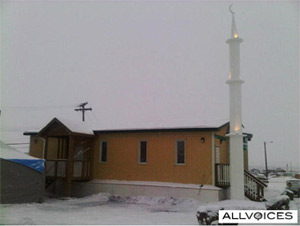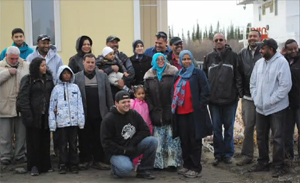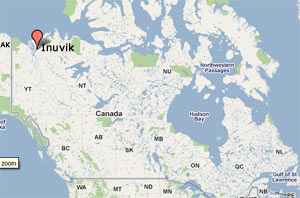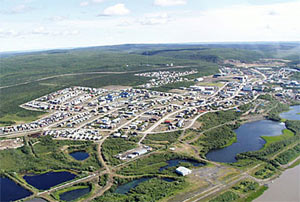The Little Inuvik Mosque

A small mosque that was shipped to the Arctic to serve a growing Muslim population in Canada's far north, arrived in Inuvik on September 24, after traveling 4,000 kilometers (2,485 miles) over land and water.
The mosque, built by a Manitoba-based Islamic charity, the Zubaidah Tallab Foundation, had been traveling to Inuvik on a flatbed semi-trailer since Sept. 1.
WaterToday talked with Saira Rahman, an independent filmmaker who is documenting the little mosque's trip and arrival in Inuvik and with Ahmad Alkhala, the man in charge of finishing the mosque in Inuvik.
 Part 1- Ahmad Alkhalaf - The builder Part 1- Ahmad Alkhalaf - The builder
 Part 2 - The documentary- First interview with Saira Rahman Part 2 - The documentary- First interview with Saira Rahman
 Part 3 - Mosque opens its doors- Second interview with Saira Rahman
Part 3 - Mosque opens its doors- Second interview with Saira Rahman
 Part 4 - Midnight Sun Mosque - Video
Part 4 - Midnight Sun Mosque - Video
Part-4
Midnight Sun Video

Part-3 - The documentary - Inuvik mosque opens its doors - Second interview with Saira Rahman 11/18/10
Saira Rahman, her sister Nilufer and their two videographers have spent about four weeks up in Inuvik since the traveling mosque arrived from Winnipeg on September 23rd.
The crew is filming a documentary on the Muslim community in Inuvik and the arrival of the new mosque in this small northern town. We reached Saira by phone in Inuvik on November 18.
What was your first impression of the North when you first arrived in Inuvik? Was there anything unexpected?
Yes, when we arrived in late September, there was very little snow and the roads were very mushy and muddy. I was surprised to see how casual the residents were about the muddy, dirty streets. It was not what I had envisioned the Arctic to be.
How would you describe the community?
Very welcoming. In fact, there is a motto in Inuvik that says the weather is cold but the people are warm. There is a very deep community spirit here.
What about the Muslim community, how well has it integrated?
Amazingly well. They are a close-knit group although they come from many different parts of the world. Inuvik is a very multicultural town. Aside from the three aboriginal groups - the Inuvialuit, the Gwich'in and the Metis - there is a growing Philippino community. The Muslim community includes groups from Sudan and Lebanon, and there is a whole family of Palestinians. Many lived in Edmonton or Calgary for a few months or years before moving up to the Arctic.
Are they Sunni or Shiite Muslims?
They are predominantly Sunni. But the community is very inclusive. The new mosque also wants to be inclusive and welcomes either religious groups. It also intends to open its doors to members of other religions.
What attracted them to Inuvik?
Mostly economics. Jobs. Offshore drilling jobs in the Beaufort Straight which is about two hours from Inuvik. These are well-paying jobs.
Do most stay once they arrive?
Yes. Actually, many come planning to stay for a few months and are still here years later.
Is offshore drilling controversial within the community?
It is. As is the Mackenzie Pipeline. The Gwich'in own the land where it is projected to run and they fear that they will have to travel farther afield to hunt big game. On the other hand, it also brings good jobs.
Is climate change a concern in Inuvik?
It is not talked about much as such but the weather today was pretty warm at 4 degrees Celsius. The ice road is expected to open shortly, as it usually does. There does not seem to be any concern that it will be delayed which is good since the community heavily relies on it.
What is the landscape like in the Inuvik area. Is it a beautiful land?
Now that it is snow-covered it is beautiful. Inuvik is on the Mackenzie Delta and you can see the Richardson Mountains on the horizon. We went to do aerial shots in a helicopter and you could really appreciate the beauty of the land.
What about water? How is the tap water?
Inuvik was built as a model town so it is very well planned. The water travels through utilidors and is always heated so as not to freeze. I have not noticed any problems so far but there was a power outage when we first arrived and I imagine there could be issues when it gets colder and the power goes off. ( See Inuvik Drum article: Frozen water lines leave homes without water(scroll down)
Would you move to Inuvik?
Given the right circumstances, definitely.
Part-2 - The documentary - An interview with Saira Rahman 9/21/10
Saira Rahman and her sister Nilufer grew up in Winnipeg. The family moved to Manitoba in the 70's after living in the UK for ten to twelve years. While Saira arrived as a toddler, her sister was born in Canada.
WaterToday talked with Saira over the phone before her departure for Inuvik where she, her sister and two co-producers, videographers Sean Parenteau and Ryan Murphy, will be shooting a documentary on the little mosque's travels and arrival in Inuvik, over the next six days.
How did you come to be involved in this documentary?
I received a call from Hussain Guisti of the Zubaidah Tallab Foundation who is managing this project, three days before the mosque's departure for Inuvik asking me if I would be willing to do a documentary on the Arctic mosque. He knew my sister and had read an article of mine and thought I would be the right person to do it.
Have you done other documentaries?
Actually we are new filmmakers. I started my career as a teacher and principal before branching out into film. I took a production course in Vancouver where I produced a student film which to my delight was accepted in three festivals. I also helped produce a three-part documentary entitled "A New Life in a New Land".
How do you produce a documentary with three days notice?
It's a challenge, in that there was zero pre-production work done when we started out. So, it's kind of like going backward. But I took it on, although I am more interested in fictional films, because I found the idea of this traveling mosque to be quirky and unusual enough, to allow for a lot of creativity.
What have you shot so far?
The two videographers have been following the mosque's route since it left Winnipeg, through the obstacles on the highways and along the final barge trip up the Hay River to Inuvik. At first it was expected that it would be delayed and arrive later than September 24 in Inuvik. But now, it's actually ahead of time. So I had to juggle our flights to be able to arrive on the same day, tomorrow the 22nd. First Air is the only airline that goes up there and it has few daily flights.
What are your plans once you are up there?
We will be doing a lot of interviews with Inuvik residents and members of the Muslim community, as well as people on the street. With so little pre-production, I expect there will be a lot of last-minute decisions as we go along.
What is the weather up there now? Are there special concerns for your equipment in cold weather?
Right now it's snow and freezing rain and the temperature is around minus 3 degrees C, so it's not too cold. We are more concerned witht the humidity than the cold at this point. The cameras can withstand that range of temperature but we have brought raingear and lenses for the cameras to deal with the humidity.
Good luck then and we will catch you when you get back from Inuvik.
Part 1- An interview with builder Ahmad Alkhalaf - 9/9/10
Ahmad Alkhalaf is a Senior Project Officer in the Public Works Department of the Northwest Territories Government, in Inuvik. On September 24, if all goes as planned, he will be the man in charge of finishing the installation of the town's first mosque.
The little mosque will arrive after traveling 4,000 kilometers over land and water,from Manitoba. WaterToday reached Ahmad at his office.
How long have you been in Inuvik and where did you come from?
I came here from Toronto nine years ago. I came to Canada from Kuwait but I am originally from Iraq.
How large is the Muslim community in Inuvik and how much has it grown over the years?
There are about 80 people and the community and it has been more or less the same since I have arrived. It has grown with the birth of new children but some people have also left over the years.
How is the Muslim community received in Inuvik and why do people leave?
The Northern people are very welcoming and hospitable. The biggest difficulty is the winter. Some peole cannot take the cold and the darkness of the winter months, so they leave.
What jobs do Muslims find up in the Arctic?
I would say mostly government and tourism jobs.
If the community has always been this large why the need for a larger mosque now?
To be honest, up until now the congregation could not afford to build a new mosque, so we started by raising funds to buy a piece of land. Building the mosque here would also have been too expensive since labor and materials are quite a bit higher than in southern parts of Canada. This is why we bought a prefabricated building from Manitoba. It was half the cost.
What will remain to be done to the mosque once it arrives in Inuvik?
A standard building custom in the Arctic is to set the building on wood piles or pads. We cannot afford the piles so we will be using pads. These are made of pressure treated wood wedges with about 1.5 to 2 feet of gravel in between. The mosque will be about 3 feet above ground once it is completed. Then we will have to finish the interior, paint, carpeting, lighting, etc.
How is water distributed in Inuvik. Are there unique challenges because of the cold weather?
We get the water from the lake and because of the cold weather, the intake pipe has to be sunk at lower levels where the water does not freeze. A system of 'utilidors' then distributes the water across the town. These are heavily insulated with electrical heating cables. It works most of the time. But at times the water freezes. But the water is very clear up here unlike in the southern parts of the country. There is a utilidor 10 feet away from the mosque so the water will be easily hooked up.
Since you have been in Inuvik have you seen any evidence of climate warming?
Yes, it has been warmer in the last two years and the summers are longer.
What about melting permafrost?
I personally have not seen any change but I have read geotechnical reports that say that there are small changes happening. I know that when it gets worse , the permafrost will simply disappear.
How does the shifting permafrost affect the foundation of buildings?
The foundation will heave if you do not adjust the wedges in the pads twice a year; in November before the cold months and in March when the weather gets warmer. That's why there is a 3-foot crawl space under the mosque.
|
Inuvik, NT

Inuvik Water
Source
In winter Inuvik draws water from East Channel. Through the ice-covered period, the
river water is clear, requiring only filtration, disinfection and 'tempering' (warming, to
prevent freezing in the distribution system).
Through the ice-free period, Mackenzie River waters are too turbid (silty) to be treated
by filtration alone. Accordingly, in summer Inuvik draws water from Hidden Lake.
Treatment
The water is treated at two water treatment plants. The East Channel Water Treatment Plant provides water tempering, turbidity reduction, disinfection (by gas chlorine) and fluoridation.
The Hidden Lake Water Treatment Plant contains chlorination and fluoridation equipment, a 410 m3
(90,000 ig) chlorine contact tank, treated water transfer pump, and ancillary systems.
Distribution
Nearly all of Inuvik's piped water and sewage system is above ground. In the first
decades of townsite development, aboveground utility pipes were carried in insulated,
heated metal or wooden boxes called 'utilidors'. 'Utilidor' now refers to aboveground
water and sewer systems generally.
The total length of Inuvik's water distribution network is 15.9 km. This includes 1.1 km
of trunk mains, most of which are 300 mm (12 in) in diameter, and 14.8 km of
distribution mains, most of which are 200 mm (8 inch); the normal minimum size for
reasons of fire protection.
Sewage Treatment
Inuvik's sewage is treated in the multi-cell lagoon system, before being discharged into
East Channel. Active wastewater treatment cells include two primary sedimentation
cells, and a large pond which operates as a facultative lagoon in summer. Two additional
cells just east of the primary lagoons are used for sludge storage.
Freeze Protection
Inuvik's aboveground utility system needs to survive the extremes of the Town's winter,
with a good margin of safety.
To protect against freezing, 'passive' systems (weather shields and insulation, mainly)
reduce the rate of heat loss as much as possible, while 'active' systems (such as water
tempering boilers, circulation pumps, heat tracing, etc) add and distribute heat to
compensate for the unavoidable losses.

|  |





